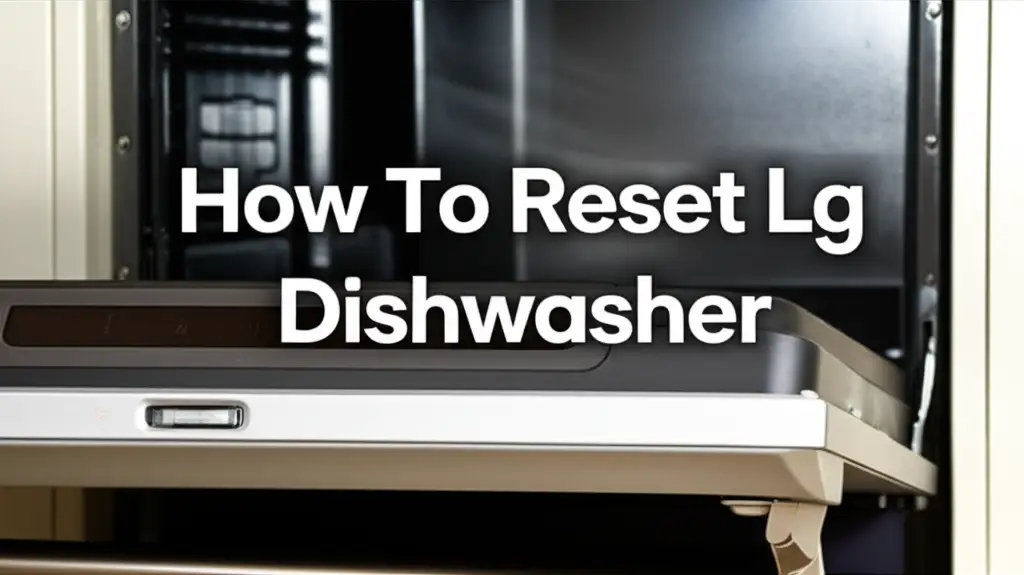· Tessa Winslow · Home Appliances · 24 min read
What Holds A Dishwasher In Place

Understanding What Holds A Dishwasher In Place
Have you ever wondered what keeps your dishwasher from tipping over or sliding around when it is full of dishes, vibrating during a wash cycle? It is an important question. I know I have, especially when watching a heavy load tumble inside. The security of this essential kitchen appliance is not left to chance. Several key components work together to ensure your dishwasher remains firmly in its designated spot, wash after wash. This article will explore the methods and mechanisms that provide crucial stability, ensuring your appliance operates safely and efficiently. We will cover everything from mounting brackets to utility connections, giving you a complete understanding of what holds a dishwasher in place.
Takeaway:
- Dishwashers use mounting brackets and leveling legs for primary stability.
- Utility connections (water, drain, electrical) also contribute to keeping the appliance secure.
- Proper installation is essential for both safety and performance.
A dishwasher stays securely in place primarily through mounting brackets attached to the underside of the countertop or to the adjacent cabinet sides. Adjustable leveling legs at the bottom also provide stability and proper alignment. Furthermore, utility connections, including water supply lines, drain hoses, and electrical wiring, contribute to anchoring the appliance within its designated space.
The Core of Dishwasher Stability: Mounting Brackets and Leveling Legs
Every dishwasher relies on a combination of mechanical fasteners to stay firmly in its cabinet opening. These fasteners prevent the appliance from moving forward or tipping, especially during vigorous wash cycles. The primary components responsible for this stability are the mounting brackets and the leveling legs. They work in tandem to create a secure and balanced installation. Without these elements, your dishwasher would be a wobbly, potentially unsafe appliance.
Mounting brackets are critical for fixing the dishwasher to surrounding structures. These small, often metal, components are strategically placed to anchor the appliance. Their design allows for a strong, direct connection to either your kitchen countertop or the side cabinets. This attachment is crucial for preventing any forward motion when you open the door or pull out the racks. It ensures that the dishwasher remains an integral part of your kitchen setup, not a loose piece of equipment.
Leveling legs provide the final touch to a stable installation. These adjustable feet are located at the bottom corners of the dishwasher. They allow you to precisely raise or lower each corner of the appliance. This adjustment ensures the dishwasher sits perfectly level, preventing water from pooling unevenly inside and minimizing vibrations. Correctly adjusted leveling legs also ensure the dishwasher’s weight is evenly distributed, which reduces stress on the mounting points.
Top Mounting Brackets: Securing to Countertops
Top mounting brackets are a common method for anchoring a dishwasher. These brackets are typically found on the top frame of the dishwasher, extending upwards. They are designed to screw directly into the underside of your kitchen countertop. This method creates a strong, downward force that pulls the dishwasher tightly against the floor and cabinet base. It is a very effective way to prevent the appliance from tipping forward when the door is opened.
These brackets are essential for stability. They come in various shapes, but their function is always the same: to create a secure connection. Installers will typically use screws that are long enough to penetrate the countertop material without going all the way through. It is important to pre-drill pilot holes to prevent splitting the wood or composite material of the countertop. This careful process ensures a snug and reliable fit.
If your countertop is made of a material that cannot be easily drilled, like granite or quartz, special considerations apply. Some brackets might adhere using strong epoxy or alternative mounting methods. However, for most laminate or butcher block countertops, top mounting provides excellent stability. This connection makes your dishwasher feel like a permanent fixture.
Side Mounting Brackets: Attaching to Cabinets
For situations where top mounting is not feasible, side mounting brackets offer an excellent alternative. These brackets are located on the sides of the dishwasher’s frame. They attach directly to the adjacent kitchen cabinets on either side of the dishwasher opening. This method is particularly useful when installing under delicate or thick stone countertops, such as granite or marble, which might be difficult to drill into from below.
Side mounting creates a robust lateral anchor for the dishwasher. By screwing into the side panels of the cabinets, these brackets prevent any side-to-side movement or shifting. They also contribute significantly to preventing the appliance from pulling forward. This secure attachment integrates the dishwasher seamlessly into your cabinetry.
The installation process for side mounting is straightforward. You position the dishwasher, then extend the side brackets and screw them into the cabinet frame. It is important to ensure the screws are appropriate for the cabinet material and length. This method is just as effective as top mounting for holding the dishwasher firmly in place. It provides strong support, keeping the appliance stable during use.
The Role of Leveling Legs in Stability
Leveling legs are simple but vital components for a stable dishwasher. These threaded feet screw into the bottom of the dishwasher frame. They allow you to adjust the height of each corner independently. This adjustability ensures the dishwasher sits perfectly flat and level, even if your floor is uneven.
Proper leveling prevents water from pooling in one area inside the wash tub. It also minimizes excessive vibration and noise during operation. A level dishwasher operates more efficiently and quietly. If the dishwasher is not level, it can cause wear and tear on internal components over time. This includes the motor and spray arms.
To adjust the legs, you typically turn them clockwise to lower that corner or counter-clockwise to raise it. Many dishwashers have two front leveling legs that are easily accessible. Some models also have adjustable rear legs, which you might adjust from the front using a wrench. Ensuring the dishwasher is perfectly level is a crucial step for long-term stability and optimal performance. This simple adjustment keeps the appliance balanced and secure.
Beyond Brackets: How Utility Connections Add Stability
While mounting brackets and leveling legs are the primary anchors for a dishwasher, the utility connections also play a significant, albeit secondary, role in keeping the appliance in place. These connections are not designed to bear the full load of stability, but their secure attachment reduces movement and contributes to the overall firmness of the installation. Think of them as additional, flexible tethers that prevent excessive shifting. These connections include the water supply line, the drain hose, and the electrical wiring. Each must be connected properly for the dishwasher to function safely.
These lines and hoses, when correctly routed and connected, provide a subtle but effective resistance to movement. They are typically flexible enough to allow for slight adjustments during installation. However, once connected and secured, they add to the appliance’s overall stability. A loose or improperly connected line could allow for more movement, potentially leading to issues. Therefore, ensuring these connections are snug and correctly routed is part of keeping your dishwasher stationary.
The connections are often routed through small openings in the cabinets or floor. This routing itself helps to guide and limit the dishwasher’s movement. It creates a defined pathway for the appliance. Proper management of these lines prevents kinks and ensures they do not pull on the dishwasher in a way that could dislodge it. These vital links are more than just functional; they are part of the stability network.
Water Supply Line and Dishwasher Placement
The water supply line brings clean water to your dishwasher for each wash cycle. This line typically connects to a hot water pipe under your sink. From there, it runs to the inlet valve on the bottom of the dishwasher. The line is usually a flexible braided hose or copper tubing. Its connection point to the dishwasher and the house plumbing adds a measure of resistance to the appliance’s movement.
When installed, the water line should have a gentle curve to allow for slight movement without kinking. However, once connected and the dishwasher is pushed into place, this line helps to ‘hold’ it. It prevents the dishwasher from being easily pulled forward or pushed back. This subtle tension contributes to keeping the appliance nestled in its cavity.
A properly installed water supply line is crucial for preventing leaks. It also plays a role in the dishwasher’s fixed position. Any tension on the line needs to be carefully managed during installation. This helps ensure it does not compromise the stability provided by the mounting brackets. You can learn more about related plumbing, such as what is an air gap dishwasher, to understand the full system.
The Drain Hose Connection and Stability
The drain hose removes dirty water from the dishwasher. It connects from the dishwasher’s drain pump to your sink’s drain pipe or a garbage disposal unit. This hose is typically made of flexible corrugated plastic. Like the water supply line, its secure connection contributes to the dishwasher’s stability.
The drain hose is often routed with a high loop or through an air gap to prevent dirty water from siphoning back into the dishwasher. This routing often involves securing the hose to the underside of the countertop or cabinet. This securing method further limits the dishwasher’s ability to move forward. The hose acts as another tether, albeit a flexible one.
A properly installed and routed drain hose ensures efficient water removal. It also helps to keep the dishwasher in its place. If the drain hose is too short or too long, it can create tension or slack that allows for unwanted movement. Ensuring the right length and secure connections is vital. For issues with draining, you might want to know how to get the dishwasher to drain.
Electrical Wiring for a Secure Fit
The electrical connection powers your dishwasher. This connection involves wiring the dishwasher to a dedicated circuit in your home’s electrical system. The wiring typically enters the dishwasher through an access panel at the bottom front. It connects to a junction box within the appliance. This connection also adds to the overall stability.
The electrical conduit or cable, once connected and secured within the junction box, provides another anchoring point. It prevents the dishwasher from being easily dislodged. While the wiring is flexible, it resists significant movement. This resistance helps keep the appliance snug against the cabinet opening.
Safety is paramount for electrical connections. All wiring must comply with local electrical codes and be properly grounded. An appliance requires a specific type of circuit. For instance, knowing what amp GFCI for dishwasher is necessary for a safe and stable electrical setup. A secure electrical connection is not just for power; it also subtly reinforces the dishwasher’s fixed position.
Preparing for Installation: Ensuring a Secure Base
Proper preparation is crucial before you even think about sliding the dishwasher into its spot. A well-prepared opening ensures the dishwasher fits correctly and can be securely anchored. This preparation involves inspecting the surrounding cabinetry and the floor. Skipping these preliminary steps can lead to a wobbly appliance or even damage over time. Taking the time to prepare the space correctly pays off in long-term stability and performance.
You want to make sure the opening is the correct size. Most dishwashers are designed to fit into a standard 24-inch wide opening. However, variations exist, and a tight fit is important for initial stability. Checking for obstructions and ensuring the floor is clean and level within the opening are also key steps. This groundwork ensures that the dishwasher will sit flush and evenly.
The goal of preparation is to create an ideal environment for the dishwasher. This environment allows the mounting brackets and leveling legs to do their job effectively. Without proper preparation, even the best mounting hardware might struggle to keep the appliance truly secure. A solid base is the first step towards a stable dishwasher.
Checking Cabinetry and Countertop Integrity
Before installing a dishwasher, carefully inspect the surrounding cabinets and countertop. The cabinets on either side of the dishwasher opening must be sturdy and firmly attached to the wall. Any wobbling or weakness in the cabinets will compromise the dishwasher’s ability to be securely mounted. If the cabinets are unstable, fix them before proceeding.
The countertop above the opening also needs attention. Check for any sagging or unevenness. If you plan to use top mounting brackets, ensure the underside of the countertop is solid and able to accept screws. For laminate or wood countertops, this is usually straightforward. For stone countertops, consider side mounting or using specialized adhesive clips if drilling is not an option.
Ensure there are no obstructions within the cabinet opening. This includes old screws, debris, or protruding wood. The opening should be clean and clear. A sound cabinet structure and a solid countertop provide the necessary foundation for firmly holding your dishwasher in place. This foundational check prevents future stability issues.
Proper Floor Preparation for Your Dishwasher
The floor where your dishwasher will sit must be clean, dry, and level. Any debris or unevenness on the floor can prevent the dishwasher from sitting flat. This can make it difficult to level the appliance properly. Even small bumps can lead to a slight tilt, which can affect performance and stability.
If your floor is significantly uneven, you may need to use shims under the leveling legs. However, ideally, the floor should be as level as possible within the dishwasher cavity. Clean up any dust, dirt, or moisture. A clean surface helps the dishwasher slide in smoothly without resistance.
Consider any flooring transitions near the opening. If there’s a lip or change in flooring height, it can hinder the dishwasher’s installation. Some people use a thin plywood base to create a perfectly flat surface for the dishwasher if the existing floor is problematic. A well-prepared floor ensures the leveling legs can achieve maximum stability. This crucial step supports the overall secure placement of the appliance. You can also review how to move a dishwasher without scratching floor for additional guidance.
The Installation Process: Step-by-Step for a Stable Dishwasher
Installing a dishwasher correctly is key to its long-term stability and performance. The process involves several careful steps, from positioning the appliance to securing its connections. Each step contributes to ensuring the dishwasher remains firmly in its designated spot, preventing any unwanted movement during operation. While a professional installer can handle this, understanding the steps helps you appreciate what goes into keeping your dishwasher secure. It is a methodical approach that ensures every component contributes to the appliance’s overall stability.
The core of a stable installation lies in careful alignment and firm anchoring. You will need to make sure the dishwasher sits squarely within its opening. Then, you secure it using the appropriate mounting hardware. Finally, you fine-tune its position with the leveling legs. This three-pronged approach guarantees the dishwasher is not only functional but also safe and stationary.
Remember, patience and precision are your best tools during installation. Rushing through the steps can lead to a wobbly dishwasher or other issues. Taking the time to do it right the first time will save you headaches down the road. A securely installed dishwasher is a quiet and efficient one.
Positioning the Dishwasher Accurately
The first step in securing your dishwasher is to position it accurately within the cabinet opening. Carefully slide the dishwasher into the space, ensuring it is centered and flush with the front of your cabinets. Avoid forcing the dishwasher, as this could damage the appliance or the surrounding cabinetry. If it is too tight, check for obstructions or ensure the opening dimensions are correct.
As you slide it in, guide the water lines, drain hose, and electrical wiring through the necessary access holes. Make sure these lines do not become kinked or pinched. They should have enough slack to allow for slight adjustments but not so much that they create a mess behind the appliance. Proper routing here prevents issues later.
Once the dishwasher is mostly in place, check its alignment. It should be straight and not angled. The goal is to get it as close to its final position as possible before making permanent attachments. A good initial position makes the next steps much easier and ensures a truly stable fit. This accurate placement sets the stage for a secure installation.
Securing the Mounting Brackets
After positioning, the next critical step is to secure the mounting brackets. If your dishwasher uses top mounting brackets, extend them upwards and align them with the underside of your countertop. Use appropriate screws to fasten them firmly into the counter. Be careful not to overtighten the screws, as this could strip the material or damage the bracket.
For dishwashers with side mounting brackets, extend these brackets outwards to meet the adjacent cabinet sides. Use screws to secure them to the cabinet frames. Again, ensure the screws are long enough to provide a secure hold without penetrating through the cabinet. It is often helpful to pre-drill small pilot holes for both top and side mounting to prevent wood splitting.
It is important to use all available mounting points. If your dishwasher has both top and side options, choose the most appropriate one for your specific countertop and cabinet setup. Some dishwashers may offer both, allowing you to choose the most secure method. Proper fastening of these brackets is the primary way to prevent the dishwasher from moving or tipping forward.
Adjusting Leveling Legs for Optimal Balance
With the mounting brackets secured, the final step for stability is to adjust the leveling legs. There are typically four leveling legs, two at the front and two at the back. Most models allow you to adjust the front legs from the front of the dishwasher. Rear legs might be adjusted using a screw from the front or by tilting the appliance.
Use a level, placed on the bottom rack or the top edge of the dishwasher, to check for perfect horizontal alignment. Adjust each leg individually, turning them clockwise to lower that corner or counter-clockwise to raise it. The goal is to make sure the dishwasher is perfectly level from side to side and front to back. This prevents water from pooling and reduces vibrations during cycles.
Once the dishwasher is level, ensure all four legs are firmly in contact with the floor. There should be no wobbling when you gently push on the corners of the dishwasher. Properly adjusted leveling legs distribute the appliance’s weight evenly. This not only enhances stability but also reduces stress on the mounting brackets. It is a crucial step for long-term performance and quiet operation.
Common Issues and Troubleshooting for Dishwasher Stability
Even with a proper installation, sometimes a dishwasher can become unstable over time. This can be due to natural settling, heavy use, or even minor shifts in the floor or cabinetry. A wobbly dishwasher is not just annoying; it can also lead to operational problems and potential safety hazards. Understanding common issues and how to troubleshoot them can help you maintain your dishwasher’s stability. I often hear people mention their dishwasher moving. The solutions are usually straightforward.
The most common sign of instability is a feeling of looseness when you open the dishwasher door or pull out the racks. You might also notice increased noise or vibrations during wash cycles. Addressing these issues promptly can prevent further problems and extend the life of your appliance. It is important to remember that dishwashers are heavy and can cause damage if not properly secured.
Troubleshooting usually involves rechecking the mounting points and leveling. It is a process of systematic inspection. Sometimes, a simple adjustment is all that is needed to restore stability. Other times, worn parts or structural issues might require more attention. I recommend always prioritizing safety during any troubleshooting.
Dealing with a Wobbly Dishwasher
If your dishwasher feels wobbly, the first step is to identify the source of the movement. Open the dishwasher door and gently pull out the lower rack. Then, try to push down on the front edge of the inner tub. If the entire appliance moves or rocks, it indicates an issue with its mounting or leveling.
Check the mounting brackets first. If your dishwasher is top-mounted, open the door and look under the countertop. Are the screws secure? Have they come loose? Tighten any loose screws. If the screws are stripped, you may need to use slightly larger screws or relocate the mounting points slightly. For side-mounted units, check the screws attaching the brackets to the cabinet sides.
Next, check the leveling legs. Use a level on the bottom rack or the top of the dishwasher. Adjust the legs until the dishwasher is perfectly level and all four legs are firmly on the floor. Sometimes, a leg can vibrate loose over time. Ensuring all legs are making solid contact and the appliance is level will often solve wobbling issues. If the issue persists, consider whether the utility connections are allowing too much play.
Preventing Future Movement and Noise
To prevent your dishwasher from becoming unstable again, periodic checks are beneficial. Every few months, or if you notice any new noise or vibration, quickly check the mounting screws and leveling legs. A quick tighten or adjustment can save you from bigger problems later. This proactive approach ensures continuous stability.
Consider adding rubber shims or vibration-dampening pads under the leveling legs if noise or minor movement is an ongoing issue, especially on hard floors. These pads can absorb vibrations and provide an extra layer of grip. They can also protect your floor from scratches or indentations from the legs.
Ensure your dishwasher is not overloaded. An extremely heavy load can put undue stress on the mounting points and increase vibrations. Also, make sure dishes are distributed evenly. Proper loading contributes to smooth operation and reduces internal stresses that can lead to movement. By taking these simple steps, you can help keep your dishwasher firmly in place and operating quietly for years to come.
Safety First: Why a Secure Dishwasher Matters
The stability of your dishwasher is not just about convenience; it is a critical safety consideration. An unsecured dishwasher can pose several risks in your kitchen, from tipping hazards to potential water damage. Ensuring your dishwasher is firmly held in place protects your family, your home, and the appliance itself. I often tell people that a stable appliance is a safe appliance. It truly is that important.
When a dishwasher is not secure, it can move forward when you open its heavy door, especially if the racks are loaded. This movement can lead to the appliance tipping, which is a significant danger, particularly if children are present. Beyond the immediate physical hazard, an unstable dishwasher can experience problems with its internal components or connections. These problems can lead to leaks or electrical issues.
Therefore, the methods used to hold a dishwasher in place are not merely installation preferences. They are fundamental safety measures designed into the appliance and its installation process. Prioritizing proper installation and periodically checking its stability is an essential part of home maintenance. It keeps your kitchen a safe and functional space.
Avoiding Tipping Hazards
An unsecured dishwasher can become a dangerous tipping hazard. This risk is most pronounced when the dishwasher door is opened. Modern dishwashers have heavy doors and racks that extend far out. If the appliance is not firmly anchored, the weight of the door and the contents can cause the entire unit to tilt forward. This is especially true if the bottom rack is pulled out and loaded with heavy dishes.
For households with children, this risk is amplified. A curious child might open the dishwasher door and inadvertently cause the appliance to tip over. This could result in serious injury or even entrapment. Even for adults, a sudden lurch or tip can cause sprains or falls. The mounting brackets are specifically designed to counteract this forward tipping force.
Therefore, ensuring those mounting brackets are properly installed and tightly secured is paramount for safety. They create the necessary resistance to prevent the dishwasher from becoming unstable when its door is open. A secure dishwasher means peace of mind, knowing that your appliance is firmly anchored and poses no tipping risk. This steadfastness protects everyone in your home.
Preventing Leaks and Damage
A dishwasher that is not stable can also lead to leaks and long-term damage to your home and the appliance itself. When a dishwasher moves or vibrates excessively, it puts stress on its utility connections. The water supply line, drain hose, and electrical wiring are all susceptible to damage from constant jarring or shifting. This constant movement can loosen connections.
Loose water supply lines or drain hoses can develop small leaks over time. Even a slow drip can cause significant water damage to your cabinets, flooring, and subfloor if undetected. Water damage can lead to costly repairs, mold growth, and structural issues in your kitchen. This is why a firm appliance is so important. If you find yourself needing to address water issues, understanding how to repair a leaking dishwasher becomes crucial.
Furthermore, excessive vibration from an unstable dishwasher can accelerate wear and tear on internal components. Motors, pumps, and spray arms might experience increased stress and premature failure. This can lead to expensive repairs or a shorter lifespan for your appliance. A secure, level dishwasher minimizes these stresses, preserving its integrity and preventing costly mishaps.
Maximizing Appliance Lifespan
Ensuring your dishwasher is properly secured and level does more than just prevent immediate hazards; it significantly contributes to maximizing its lifespan. When a dishwasher is unstable, it experiences constant subtle movements and vibrations. These movements create unnecessary stress on all its internal working parts, from the motor to the rack rollers. Over time, this wear and tear can lead to premature breakdown.
A level appliance ensures water drains efficiently and internal components, like the wash arm, spin without obstruction. This optimal operation reduces strain on the pump and motor. When the dishwasher is not level, water may not drain completely. This can lead to foul odors or even mold growth inside the tub. You might want to understand how to clean mold off dishwasher if this happens.
By keeping your dishwasher firmly anchored and perfectly level, you allow it to operate as designed. This reduces unnecessary stress, minimizes noise, and prevents potential damage to connections. Investing a little time in proper installation and periodic checks pays off by extending the life of your dishwasher. It ensures you get the most out of your appliance for many years to come.
Frequently Asked Questions
How do I know if my dishwasher is properly secured?
You can check your dishwasher’s security by opening its door. Then, gently pull on the lower rack. If the entire appliance moves or rocks forward, it is likely not properly secured. You should also check for any visible gaps between the dishwasher and the countertop or cabinets. A stable dishwasher feels solid and does not shift.
Can I install a dishwasher without mounting brackets?
No, you should not install a dishwasher without using mounting brackets. These brackets are essential for preventing the appliance from tipping forward, especially when the door is open. Relying solely on leveling legs or utility connections is insufficient for safety and stability. Always use the provided mounting hardware.
What if my countertop is granite and I can’t drill it?
If your countertop is granite or another stone material that cannot be drilled, use side mounting brackets. These brackets attach the dishwasher to the adjacent cabinet sides. Many modern dishwashers include both top and side mounting options for this reason. Alternatively, some installers use strong adhesive kits for stone countertops.
How often should I check my dishwasher’s stability?
It is a good idea to check your dishwasher’s stability every 6 to 12 months. This quick check can involve gently wiggling the appliance and ensuring the mounting screws are tight. If you notice any new noises, vibrations, or movement during a wash cycle, check its stability immediately.
What causes a dishwasher to become wobbly?
A dishwasher can become wobbly due to several reasons. The most common causes include loose mounting screws, leveling legs that have shifted or become uneven, or sometimes slight settling of the floor or cabinetry over time. Heavy or unevenly loaded cycles can also exacerbate existing stability issues.
Conclusion
Understanding what holds a dishwasher in place is key to ensuring your kitchen appliance is both functional and safe. We have explored the crucial components, primarily the mounting brackets and leveling legs, which work together to anchor the dishwasher firmly in its designated spot. We also discussed how utility connections, such as the water supply line, drain hose, and electrical wiring, contribute to this overall stability. Proper installation, including preparing the space and carefully securing each element, is not just a best practice; it is a necessity for preventing hazards like tipping and leaks.
A secure dishwasher operates more efficiently, quietly, and reliably, extending its lifespan and protecting your home from potential damage. Regularly checking the stability of your appliance can help you catch and correct issues before they become significant problems. By prioritizing a stable installation, you ensure your dishwasher remains





